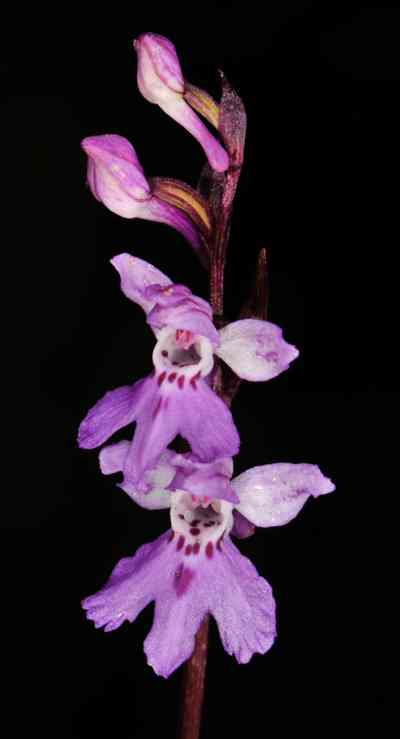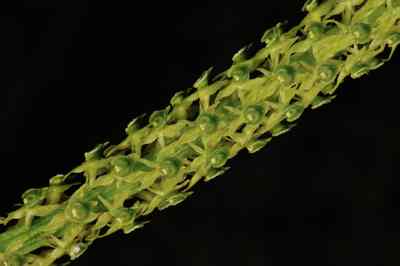The Plant
Terrestrial. Whole plant 12 to 26 cm in height. Tuber two, unequal and attached to each other with a small fleshy attachment, obelliptic to obovate, 1 to 1.5 cm long and about 1 cm in width at its widest part, naked. The new and small tuber developing to a matured one for the corresponding year. Stem arising from the apex of the matured tuber, almost two-third in height of the whole plant, cylindrical, naked and minutely narrowing towards its apex, faintly ribbed. Leaves two, unequal, arranged distance apart, 2 to 5 cm long and less than 1 cm in width, oblanceolate with broader base, sessile and clasping. The lower more than twice long as the upper one. Flowers 4 to 7 in a terminal spike much narrow than the stem, not secund.
The Flower
Flowers 2 to 2.5 cm long diagonally. Sepals un-equal; dorsal smaller than the lateral, lanceolate to ovate, arching over the petals, one nerved; lateral ovate with narrowing and wavy apex, spreading, three nerved. Petals slightly longer than the dorsal sepal, ovate, arranged forward with curving and over-lapping apex, one nerved. Lip distinctly and deeply three lobed, mid and side lobes as long as the lateral sepals; mid lobe narrow and short than the side lobes, oblong; lateral diverging, obelliptic with wider apex and sickle curve inner margins, apex margin with many wide round teeth. Spur longer than the lip and the ovary, slightly curved, cylindrical with wide base and apex, tip rounded. Leaf bract of varying size, diminishing towards the apex of the plant, lanceolate, erect or horizontal, 1 to 4 cm long and less than 1 cm in width, three nerved, arising from the upper base of the ovary.
Stem pale green reticulated with pink throughout, except near to the base of the two leaves, where it is pale green. Floral spike of a darker pinkish brown shade.
Sepals and petals pinkish white turning pale pink towards its apex with many irregular darker spots and markings. Lip of a darker pinkish shade throughout with a few distinct elongated spots on its base margining the mouth of the spur, the mid lobe also got few irregular markings of the same dark shade. Spur pinkish white at its base turning pale pink to its apex. Floral bract brownish green on its upper portion and pinkish brown on its lower portion.

The Pursuit
A beautiful small plant of the Alpine slopes, spread across half the length of the globe, from the mountains Siberia to the Himalayas. During my research time I searched many books by Indian “scientists” for a good documentary evidence (photograph) of this plant in vain. However, many lengthy articles were published on this species. As there was no proper documentary evidence for reference on this species, the species found a special mention in my list for the Alpine hunt.
King and Pantling had mentioned its altitude between 10,000 and 13,000 ft and blooming period as July and August. I moved to the high alpine areas by the first week of June and was working relatively in the lower altitudes during the first month. By July, I became very much accustomed with the high alpine region and was able to cover many unexplored regions and discovered several undocumented species. But, this one remained elusive. The description of the species and an analysis of its other habitats across the globe prompted me to concentrate on wet open slopes for the species. In the alpine region, the higher we go the drier the slopes are. However, the region in mention by King and Pantling comes in the wet zone, especially in the monsoon months between June and August.
Several days went by without a trace of the species. As those days were my first visit to the alpine zone, I was travelling all over the region every day. Repeated failures to locate the species in vain prompted me to assume that the species may have gone extinct. As the area I was covered was negligible in comparison to the vast Himalayas, I was certain I would find it from another habitat. Hence, I moved to another location in pursuit of the species.
On the fifth day at my new location, during our breakfast meeting my local guide informed about an open valley surrounded by very high mountains. He also explained to me the difficult climb up an 18,450 ft high pass to reach the location. I was eager to visit the location, however the guide was very much reluctant to accompany. It took a couple of days to convince him to accompany me. Another two days also went past in organising the journey including yaks to carry tent and other necessary food items for the 6 day up and down trek and a couple of days stay in the valley. The journey was very tedious; the uphill climb was very hard. We were able to trek hardly for 4 hours a day. On the second day, we camped at the top of the pass at 18,450 ft. While pitching tent, the strong winds blew our tent downhill. We were forced to spend the remaining part of the day and night inside the erected tent, so that our weight would prevent the winds from blowing away the tent. On the third day, we descended down to the valley to a much lower altitude of around 16,750 ft, which was more than 20 to 25 sq. km. wide. Even though, the trek was tedious and hard, I found a couple of rare species during this trek.
Early next morning, I started my pursuit in this new habitat, thus becoming the first botanist to step foot there. As the valley was surrounded by high hills, there were no winds; the air was steady. Even the percentage of oxygen was high, easing our breath. The first two hours went enjoying various flora of the new “world” and documenting some other Alpine flowers. As I was surveying the banks of a narrow stream, I stumbled across a patch of this species with most of them in bloom. The plants were with unnoticeably small narrow leaves and wide pink flowers. They were all growing near to each other thus making a carpet of pale pink. The habitat was about 12 to 15 ft wide and some 20 ft in length. Even though not precise, I counted about 45 specimens in that habitat. To select a few plants to document from a beautiful set of plants was always a very difficult task. Each one seems to be better than the other.
Finally, I zeroed on seven plants for study and documentation and produced some perfect documentary evidences, probably for the first time in the history of the species from the region. We spent another six days there re-discovering another few species, thus creating history. The return journey was made very tedious with the blessings of the rain god.
Reference:
King, G. & Pantling, R. (1898). The Orchids of the Sikkim-Himalayas. Ann. Roy. Bot. Garden. (Calcutta). Orchis chusua Don., Page no 303/304.


